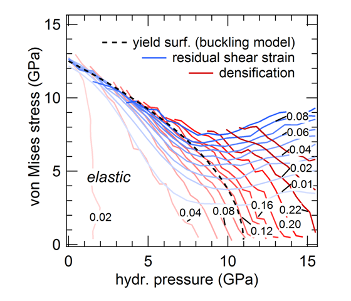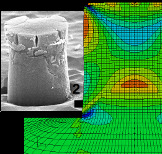Accueil > Plastic deformation of amorphous silicates > Impact of pressure on plastic yield in amorphous silica
Impact of pressure on plastic yield in amorphous silica
dimanche 13 mars 2016, par
For the plastic flow of silicate glasses, the coupling between pressure and shear is still a debated issue. The problem is especially acute for amorphous silica, which is prone to densification due to large free volume. Here we have used Molecular Dynamics simulations of a model iono-covalent amorphous solid with large free volume to investigate this coupling. Of course this model tries to emulate amorphous silica.

- Calculated silica yielf surface
- Distribution of residual volumetric strain (densification) and residual shear strain as a function of loading (maximum hydrostatic pressure and maximum von Mises stress). This map delineates a yield surface with strain hardening. A simple buckling instability model predicts the overall parabolic shape of the surface quite accurately.
The most interesting result is the shape of the yield surface : the MD simulations result in a quasi parabolic yield surface (Figure). This is not too far from the elliptic shape we assumed for our previous constitutive equation (Kermouche et al. Acta Mat. 2008). The main discrepency lies near the pure shear regime, which is experimentally difficult to access.
Remarkably, this parabolic shape has been predicted by Lambropoulos (J. Am. Ceram. Soc 1993) a number of years ago, based on a simple buckling model. Therefore, the idea that buckling is key to the anomalous mechanical properties of amorphous silica pervades the plastic response as well.
The major remaining question is when do shear bands appear in amorphous silicates, and how can we deal with them at the continuum scale ?
Publication
- Boris Mantisi, Guillaume Kermouche, Etienne Barthel & A. Tanguy, Phys. Rev. E. 93, 033001 (2016) - Journal Page, Preprint (Hal)
 MultiSil
MultiSil